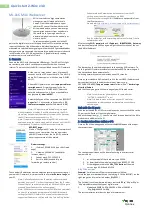
CHAPTER 4 Adaptive Server IQ Indexes
169
Table versioning controls access to join indexes
Any table is only available for write use to a single user at any given time. For
join indexes, this means that when one user is updating any table in a join
index, no one else can update any of the tables in that index. All the joined
tables remain unavailable until the first user’s transaction is committed and you
have synchronized the tables with the
SYNCHRONIZE
command.
Other users receive the following error while the join index tables are in use:
Cannot write to this table in current transaction.
Another user has write mode access.
Their current transactions cannot write to any of the join index tables; they
must begin a new transaction to write to those tables.
For more information on versioning, see Chapter 8, “Transactions and
Versioning”
Estimating the size of a join index
Adaptive Server IQ provides a stored procedure,
sp_iqestjoin
, to help you
estimate the size of a join index.
You run this procedure for each pair of tables being joined. Each time you run
the procedure, you must supply the following parameters:
•
Name of the first table to be joined
•
Number of rows in the first table
•
Name of the second table to be joined
•
Number of rows in the second table
•
Relationship (default is one-to-many)
•
IQ page size (default is 65536 bytes, or 64KB)
Many factors affect the size of a join index, especially the number of outer joins
it includes. For this reason, the procedure offers you three types of results. If
you know you will always join the tables with exact one-to-one matches, use
the “Min Case index_size.” If you anticipate occasional one-to-many joins, use
the “Avg Case index_size.” If you anticipate using numerous one-to-many
joins, use the “Max Case index_size.”
Summary of Contents for Adaptive Server IQ 12.4.2
Page 1: ...Administration and Performance Guide Adaptive Server IQ 12 4 2 ...
Page 16: ...xvi ...
Page 20: ...Related documents xx ...
Page 40: ...Compatibility with earlier versions 20 ...
Page 118: ...Troubleshooting startup shutdown and connections 98 ...
Page 248: ...Importing data by replication 228 ...
Page 306: ...Integrity rules in the system tables 286 ...
Page 334: ...Cursors in transactions 314 ...
Page 396: ...Users and permissions in the system tables 376 ...
Page 438: ...Determining your data backup and recovery strategy 418 ...
Page 484: ...Network performance 464 ...
Page 500: ...System utilities to monitor CPU use 480 ...
Page 514: ...Characteristics of Open Client and jConnect connections 494 ...
Page 536: ...Index 516 ...
















































